Going back to the drawing board for my self-fabricated plywood yielded excellent results.
The problem presented by my previous attempt, unique in my experience of making several other plywood pieces from veneers, led me in a different direction. Given the performance needs of the completed panels the obvious option of hammer-veneering the laminae with hot animal hide glue was not a realistic option as the panels need to perform in a variably hostile environment. Instead I went back to an old favorite for this sort of gluing — marine epoxy.
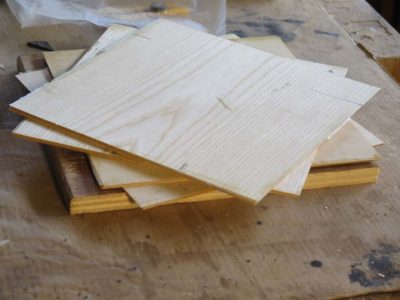
I repeated the same steps as before using another couple of sheets of the prime ash veneer but substituting old favorite West System Epoxy for the PVA, eliminating any delierious moisture response in-process.

The results were entirely satisfactory, yielding 5-ply panels just under 1/8″ and 7-ply approximately 3/16″ so I can now proceed with the project.
Quoting the title of my least favorite song from probably my most favorite current band, I recently had a spectacular failure on something entirely mundane in the shop.
The locus of the action was my Kindle. I love having a Kindle, the ability to download and have a multitude of audio and textual books in-hand on a wisp of a tool is intoxicating. Plus, I can make the font size as large as I want, no small feature for someone with my eyesight. However, the Kindle is not a particularly robust tool and I fractured the screen soon after getting it. Nevertheless I continued using it without incident for a year until the design flaw in the re-charging port caused the unit to fail entirely and I replaced it. Mrs. Barn is on her second Kindle for exactly the same reason.
When my new Kindle arrived it was instantly apparent that the geniuses at Amazon recognized the re-charging port problem and upgraded the hardware considerably. Still, that would not really help me if I abused the unit physically to the point of breaking it. So, I decided to make a lightweight rigid case to house it. I had looked at a number of manufactured cases and even bought one but remained unsatisfied, hence my desire to make my own. I might have used some 5-ply 1/8″ aircraft plywood but unfortunately my inventory of this esoteric and very expensive material was inadequate for the project.

Instead I tried making my own, an undertaking I had engaged in numerous times. Over the years I have accumulated a sizeable pile of veneer sheets and this was a perfect time to consume a tiny bit of it.
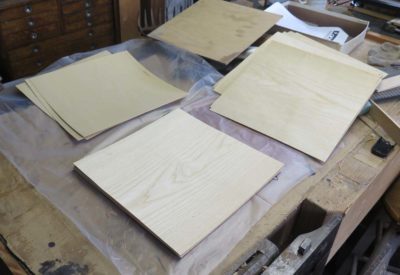
Cutting several pieces from the long veneer sheets, I glued up some 5- and 7-ply panels using some PVA adhesive.

I stacked the wet panels on top of each other with a sheet of food wrap between them, as I done done many times before. Since I do not have a veneer press I added flat cauls and a couple hundred pounds of firebricks on top and let it sit overnight.
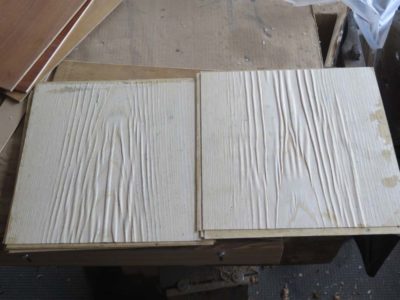

What I found the net morning on disassembling the set-up was not what I wanted, to say the very least. One of the plywood panels’ faces was perfectly flat, but the other was puckered beyond repair, or at least beyond any repair I wanted to spend my time on. Besides, I have a lot more veneer to play with.
Indeed, this was a spectacular failure.
Back to the drawing board. Stay tuned.
As I continue plugging away at the book manuscript, reviewing and editing the Gragg video, and pinstriping the Gragg chairs in the studio, I have a number of disruptive smaller(?) projects to refresh my mind.

Though not really “smaller,” since we have had lows approaching freezing it is time to finish off the firewood tasks for the upcoming winter. I’ve pretty much got the barn situated, with only another hour or so of work left to do. Actually I got so much firewood there I need to move the pile and put a fireproof barrier between it and the stove. I’m about 1/3 of the way with the cabin woodpile, so have set aside this entire week to finish splitting and stacking the firewood we will need for a severe winter. We’re hoping the winter will be mild, but nevertheless will be ready if it is not.

Long ago I started to make a set of stacking octagonal boxes to be another experiment in my quest for faux urushi, and they are sitting on my finishing bench patiently awaiting my artistry.

I’ve got a silverware box I picked up somewhere along the road to serve as the foundation for another faux urushi experiment.

I am determined to finally finish fabricating my invention for an “off” eye rifle scope. The alternative is to learn to shoot left-handed, which I can do as demonstrated by the dead groundhog that had been sniffing around Mrs. Barn’s garden, but I am right handed and have shot that way for the past 50 years. I’ve ordered the last little pieces of material necessary and can resume that project any time now. If the first prototype works like I think it will I will make a similar device for all the relevant tools.
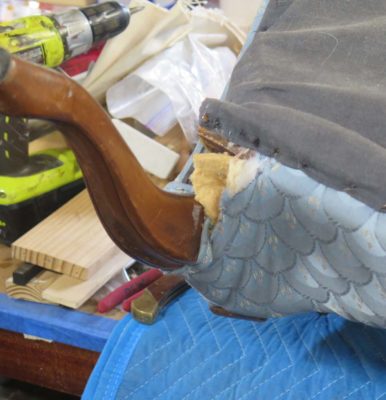
Finally, I need to shim and re-hang the barn’s basement door, build the doors for Mrs. Barn’s clothes cabinet, refinish the dining chairs, finish hanging the remaining doors for the library book cabinets, repair a broken upholstered chair frame for a friend, and begin preparations for next year’s “Build A Gragg Chair” workshop including moving a coupe workbenches up to the fourth floor. The list is never ending. I’m 65 and “retired” and still do not have enough time and energy to get everything done.
It seems like it was almost three years ago that videographer Chris Swecker and I met over lunch to brainstorm about producing videos in the Attic Studios of The Barn On White Run documenting the entire process of building the premier version of a Samuel Gragg Elastic Chair. Oh wait, it was almost three years ago.
Last week we actually concluded the video capture portion of the project in our 18th (!) recording session, resulting in almost 34 hours (!!) worth of electrons in the can. Or, 68 hours if you calculate the close-up work that was simultaneous to the wide screen shots. Now comes the tedium of my reviewing every second of video to create Cut Sheets which are the road map for Chris to execute the editing and final assembly.
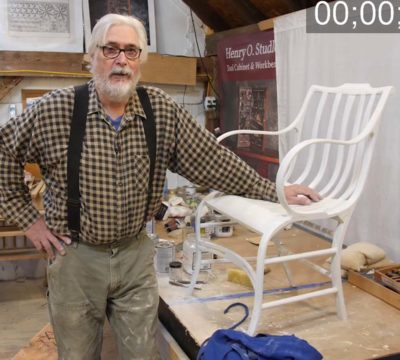
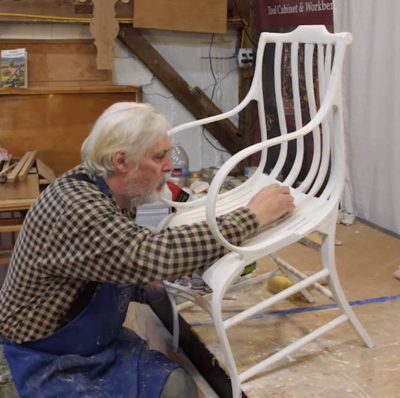
This final session was a bit of a grab-bag as you might expect, completing the project but also juggling in several other elements to be captured in a non-linear schedule for the day. In a conceptually linear recitation of the content, we began with the primed chair, then mixing the fill putty and inserted it into all the spaces that needed a bit of filling.

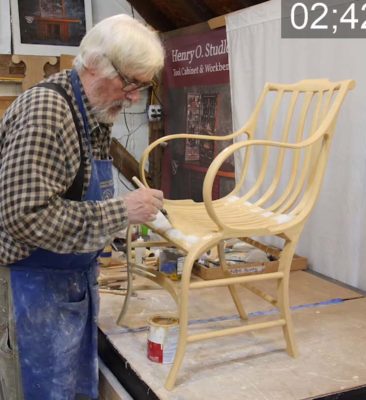
That was followed by a through sanding of the entire surface in preparation of the final cream-color base coat.


We wrapped up that portion with a discussion of the variety of striping brushes in my kit, followed by a short demo of pinstriping. The entire pinstriping process is too lengthy to record live so we will instead rely on a gallery of step by step still shots for instructional purposes. If you will recall the recorded the painting of the peacock feather by my dear friend Daniela last year.

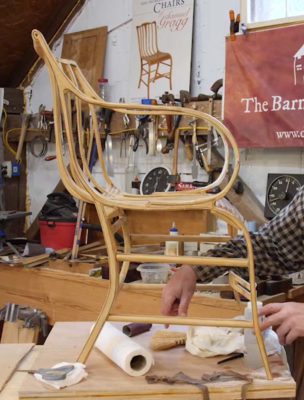
We wrapped up the content with a final session of our bonus video on the restoration of my first full-to-the-brim Gragg chair from a decade ago that had its arms crushed.

It has certainly come a long way.
I now have to construct the entire contents into chapters, the subjects of which are likely to be:
- Harvesting The Wood
2. Preparing The Stock
3. Creating the Patterns
4. Building The Forms
5. Steam Bending The Elements
6. Assembling the Side Structures
7. Fitting the Seat and Crest Rails and Rungs
8. Fitting and Installing the Continuous Slats
9. Fitting and Installing the Seat Slats
10. Sculpting the Chair
11. Painting
12. Pinstriping
13. The Peacock Feather
14. Bonus – Conserving the Damaged Gragg Chair
My goal is to have each of these sections 45-60 minutes long, perhaps with more detail than a casual viewer would like but more akin to what a maker would want.
I am diligently reviewing the raw videos for an hour or two each day and will forward the Cut Sheets to Chris as they emerge from the process so he can begin the editing and assembling right away.

Somewhere in the distant mists of time I obtained two propane-type smelting furnaces, thinking I was going to get into metal casting in a bigger way than I have. I now have no expectation of this, instead focusing on smaller castings using my electric smelting furnace. These two have simply become space eaters and I just want them gone from taking up space that is more valuable for storing yard equipment and firewood. If you want them or know anyone who does, just let me know.
These do not have burner nozzles nor the requisite plumbing but that is pretty straightforward AFAIK.
Sometimes it is the very small or simple things that make life out here in Shangri-La rewarding. Some recent happenings and observations certainly fit into that description.
Last winter we had several large trees removed from alongside the driveway, and to make that happen with the least disruption and greatest efficiency I dismantled all the split rail fencing on either side of the road. The rail pieces were stacked at the edge of the yard awaiting reinstallation. My brother visited recently and we got about half of the fencing re-built, and earlier this week I finished the job. Given my temporarily limited mobility it was a slow process of negotiating uneven and rocky topography, but slowly and surely it came together over parts of two days (it also happened to be pretty hot days for September in these parts with temps in the low 80s. Unseasonably warm!)
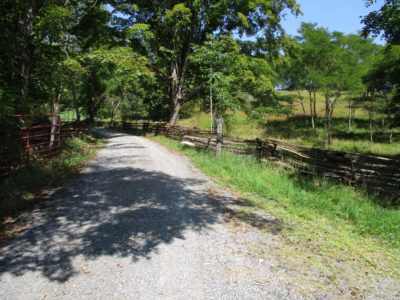


The result is both mundane and sublime, slowly sorting through the split rails and placing them to find the best fit for every stick. I was also hindered by a diminished inventory as a goodly number of the rails were degraded or damaged to the point where they were not useful in this application. Still I was able to construct substantial sections of fencing, enough to re-establish the charm of our driveway appearance.
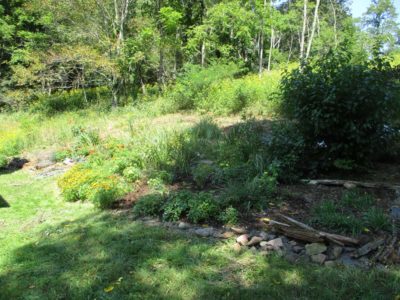
About one truckload of these unusable rails went straight up into the basement of the barn to be sectioned on my chop saw and used as firewood (it still burns great especially as fire starting material). Another truck load was leaned against a tree adjacent to Mrs. Barn’s flower garden that she has carved out of the hillside next to the cabin. I take no responsibility for it whatsoever beyond helping to move some of the materials, like these rail pieces that she will use for terracing and such. The season for flowers is mostly past and the brilliant colors of last month are faded, but she plans to expand and extend the garden another twenty feet or so to the rear so she can admire the flowers directly from the kitchen window. I am not a flower aficionado but they sure do add a sparkle to the homestead.
On top of that we are seeing the first hints of fall color as a few leaves of the walnut trees are turning yellow, the maple trees are showing their first hints of vermilion, and the locusts are soon getting their rust color. In another week or two the hillside will be an explosion of color. Perhaps not as brilliant and varied as my left leg, which from knee-to-toes looks like someone painted a psychedelic mural on it.
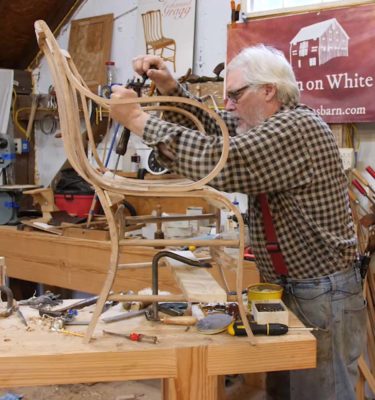
Notwithstanding the harried pace of the summer, videographer Chris Swecker and I were able to finally nail down some dates for collaboration in the video studio, a/k/a the barn attic, to finally wrap up the electron capturing portion of the project.

This next-to-last day of recording was consumed entirely with a discussion of the joinery and assembly strategy for the chair overall, and sculpting the edges and details of the chair which gives it the elegance it possesses.
One more session and then it is all editing, all the time. Which gives me two giant projects to edit and massage.
In the aftermath of my “attempted suicide by lawnmower” I spent the afternoon in low intensity activity in the shop. Most of that time I spent finishing off the negoru finish on my sandpaper box. I cannot exactly recall where I found this box years ago but it suits my need perfectly for a place to house the 1/8th sheets of sandpaper that I use for most of my work. In the past few weeks I’ve been using this project and others as diversions to recharge my batteries when I get tired of writing.

For the past several few years the box has been performing its tasks while only partially dressed, wearing only a nice coating of my favorite primer called “Sanding Putty” from Fine Paints of Europe. Crazy expensive but worth every penny. In the past few weeks I’ve been using this project and others as diversions when I get tired of writing. I’m sorry I do not have a picture of the box at this point, the project was just a whimsy at the beginning. I have another box I am likely to use for the same finish, and when I do I will document it more carefully.

After sanding the primer I laid down two coats of Schreuder Hascolac red paint to provide the chromatic foundation for the final presentation. This also comes from Fine Paints of Europe but I think they have changed the product nomenclature since I bought mine. Like the Sanding Putty these paints are simply incomparable to anything else I found in the market. I wet sanded between coats with 600 sandpaper.
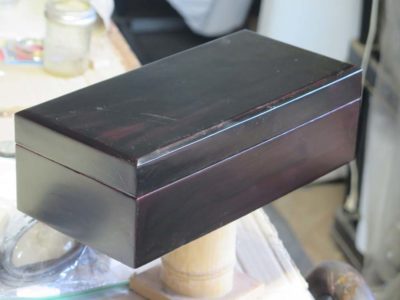
Once the foundation was ready (I usually wait a week between each coat of this oil paint) I wet sanded again and added a single coating of the Schreuder black paint.
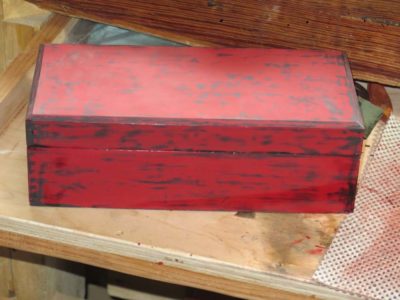
Then using 400 wet-or-dry sandpaper I abraded away most of the black to an appearance I liked.


This was followed by several applications of Epifanes Spar Varnish, a European analog to Waterlox Original Gloss Varnish. I had never used Epifanes before but it is highly regarded in the architectural restoration world and I had some so I thought I would give it a try. It certainly does lay down nice. As before I gave it a nice sanding between coats.
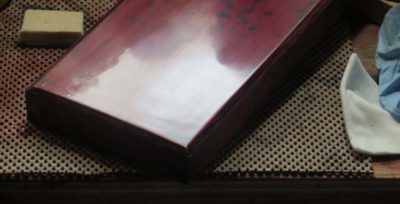
Once it was all done and the varnish was hardened, always an issue with spar varnishes as they are formulated to not get as hard as regular varnishes, I set out to polish it up. This began with a wet sanding of 1500 grit sandpaper, followed in turn with 1 micron and .05 micron agglomerated microalumina abrasives. For flat surfaces such as these I use homemade blocks of 1/2″ soft-ish felt glued to a thin plywood backing, with mineral spirits as my slurry liquid

All that is left is the very final polishing with whiting on my dampened fingertips, a maintenance coating of Mel’s Wax, and it will be done.

Not bad for just a time-killing whimsy.
I had a close call today, a couple inches one way or the other, a couple degrees more off center, or a slight differential in the gravitational constant and Mrs. Barn would be trying to figure out how the survivor benefits of my pension plan worked.
The weather has been uncooperative lately, raining a lot and clear only when I was unavailable to mow, so the grass was getting mighty lush. Today it was supposed to rain in the afternoon, and the grass was wet from a light overnight rain, but it was not raining this morning. So, I decided that even though the grass was wet my new monster riding mower could at least knock it down. It’s a 24 HP V-Twin Husqvarna with a 48″ deck and can pretty much mow the whole place except for the trim work in under two hours, including the hillside next to the pond.
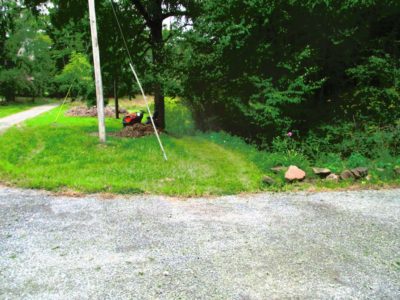
I was zipping around getting it done and was working between the driveway and the creek. When I turned the wheel to the left just before the mulch pile, due to the slickness of the wet grass the mower went straight and then off the edge of the ravine with the creek. In the blink of an eye I was tumbling down while in the saddle of a quarter–ton machine that was in the process of flipping over on top of me. It happened so quickly I had no time to react. A six-foot fall later I wound up prostrate in the creek underneath the overturned mower resting on my legs. Seriously, had it gone an inch or two one way or the other, or rolled another couple of degrees, it would have snapped my legs and been resting entirely on my torso/chest. It could just have easily been a fatal mishap in that event. As it was the mower was balanced precariously, trapping but not really damaging my legs. I lay extremely still so as not to disturb the entropy of the situation.
I gently called my bride over from her gardening to assess the situation, and at first she did not know where to go since I was out of sight She immediately called 911 and they sent out the call to any volunteer rescuers in the neighborhood. In about ten (?) minutes the first rescuer ( a Deputy Sheriff) arrived but the machine was far too heavy for him to budge (Mrs. Barn had known at a glance she could not help physically). Soon two more rescuers arrived, and it took all they had for those three burly mountain men to roll the mower just enough for me to withdraw my legs and feet. With the Deputy’s help I was able to extract myself from the invigorating experience of laying in 56-degree water with a rough bed of rocks underneath me. By then the Rescue Squad ambulance and attendants arrived and I scampered up the ravine wall and they checked me out. Well, maybe not actually scampering, but I was upright and under my own power after the numbness of my feet was gone. My BP was 130/70, my heart rate was ~70, and my respiration about 18. One of the medics asked me how I could be so calm, but I figured the jitters would probably come in a couple hours (they did not)
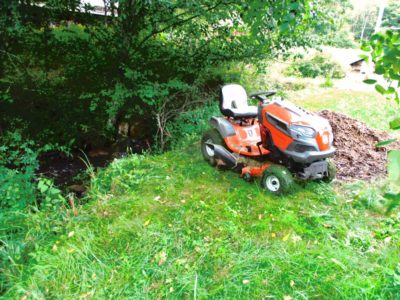
After I assured them I was not badly injured, the first rescuers rolled the mower upright and out of the creek bed and towed it up the ravine bank and back up onto good flat ground. The “hood” had all come apart and was whomperjawed, but it is all snapped together in the first place and I did not observe anything broken. I am certain I can put it all together without much fuss. I let the mower sit until after lunch and it started right up, blew out a little oily smoke from being upside down, and drove into the barn without a hitch.
I probably should have had two broken legs and at least one broken foot/ankle, and substantial structural damage to the torso and head. But, nothing much at all. My left shin and calf are pretty sore and swollen and will really hurt tomorrow. My right triceps is sore as is a right rib from laying on the rocks in the creek bed. Oddly enough my gimpy knee seems to have emerged unscathed. There may be other sore places tonight or in the morning, but I call out fervent thanks for God’s mercy in saving me from any more serious injury, or sparing Mrs. Barn far-too-early widowhood. God’s lovingkindness is ever bountiful, even when things do not go especially how we would like them, and even more especially when we do them to ourselves. It is truly miraculous, and I do not use the word as hyperbole, that I was not seriously hurt or killed. Given the situation it should have been catastrophic,
I will now know to not mow anywhere close to the creek with the lawn tractor, no matter what.
I spent the afternoon working in the barn and will probably take it easy this evening. I now pray for a painless and dreamless night’s sleep.
Singing the Praises of God’s Providence
D









































Recent Comments